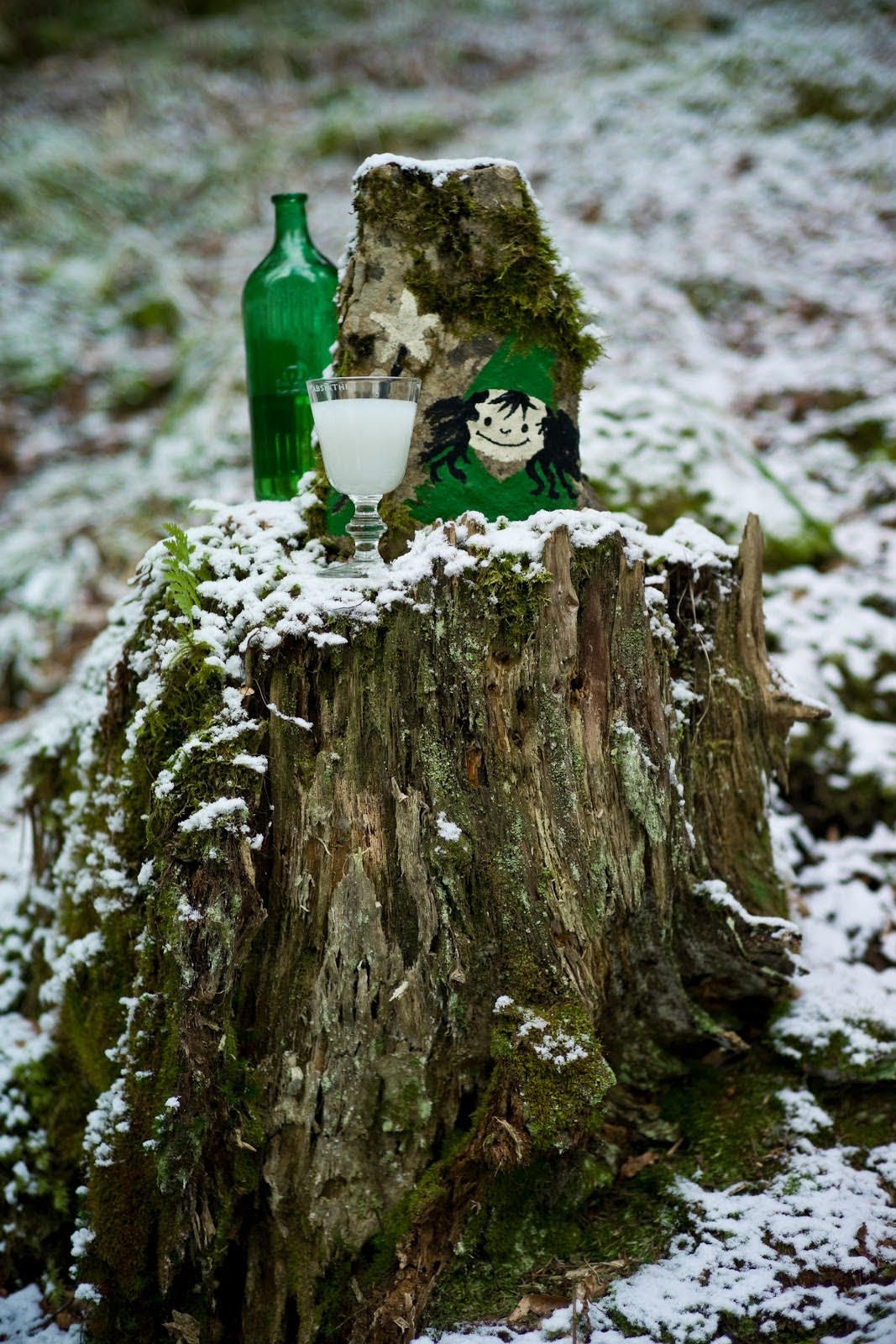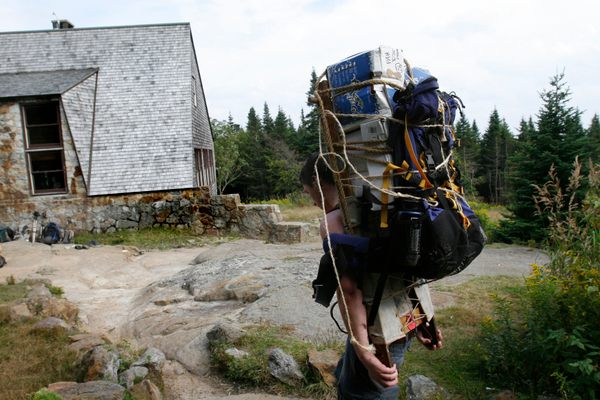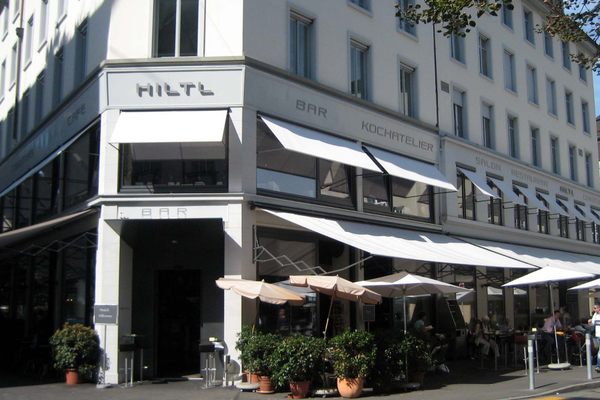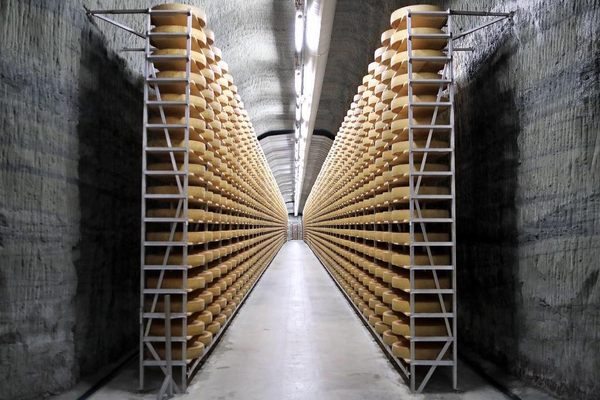The Absinthe Enthusiasts Hiding Bottles in the Swiss Woods
In the Val-de-Travers valley, people never stopped distilling the spirit.

Within the Val-de-Travers, a lush valley in western Switzerland next to the French border, lies a forest straight out of the Grimm brothers’ tales. Replete with gnarled pine trees, whimsical rock formations, and cushioned moss, this area is the birthplace of absinthe, the spirit made from regional herbs such as wormwood. Nicknamed “the green fairy,” it was banned for a century because of fears about its potency.
Absinthe reemerged in 2005, yet these woods still hold its secrets. Here bottles of the spirit are hidden away, tucked into the likes of babbling brooks. Thirsty hikers are then invited to take a swig.
At a time when distillers around the world have increasingly started producing the spirit, these hiding places, called fontaines froides (or cold fountains), recall the cloak of mystery that once surrounded absinthe. The tradition was borne from the valley’s water and its flora, as well as its residents’ love of walking and ingenuity. The absinthe enthusiasts that continue to maintain these secret stashes are carrying over their dedication to the spirit into a brand new era. With it, they hope to strike a balance between local lore and a modern revival story.
“Sometimes we’re the ones to replace an empty bottle, sometimes it’s the green fairy herself,” says Yann Klauser with a laugh. Klauser is the director of the Maison de l’Absinthe, a museum that opened its doors in 2014 in Môtiers. “It’s one of the last remnants from the time when absinthe was clandestine, because it’s still sort of illegal to do this, but it’s just something we keep up for ourselves,” he says.
Absinthe first emerged in Couvet, a town nestled in the Val-de-Travers, in the late 18th century. The drink, made of wormwood, anise, fennel, and other local plants, had an alcohol by volume level that sometimes reached 70 percent. In the 19th century, distillers in Switzerland and nearby France, most notably the town of Pontarlier, began to commercialize the green fairy.

While it took off in Parisian clubs, its popularity came with rumors that the spirit caused people to hallucinate or become violent. In 1910, the Swiss authorities officially banned the sale and production of absinthe. That made it even more popular among the Parisian elite of the time, and the fact that it found fans in the likes of Ernest Hemingway only further contributed to its mythic status.
The Val-de-Travers fountains have an even longer lineage. Historians have found 19th-century letters referencing bottles of absinthe stored along walking trails in the valley’s woods. But during the clandestine period, these fountains acquired their aura of resistance. After the 1910 ban (most valley residents can cite the date from memory with a little shudder) absinthe distillers went underground for more than a century. Despite the ban, people never stopped making and drinking absinthe in the Val-de-Travers.
The region’s isolation helped protect it from federal oversight, and local authorities mostly looked the other way. According to an oral history recorded by Nicolas Giger—who has long promoted absinthe as the president of the Pays de l’Absinthe association—one local judge would even send his son to pick up bottles from a distiller. Another once told a distiller who’d received a fine that the charge was more of a business card than a punishment. The spirit was so prevalent that a local Swiss chef served French president François Mitterand a soufflé with absinthe in 1983, an infraction the authorities only investigated after pressure from the French media.
That’s not to say that absinthe lovers were completely immune to scrutiny, as Giger recalls. When the federal authorities cracked down hard in the 1960s, they fined dozens of distillers into or near bankruptcy. Distillers and restauranteurs were known to quickly hide their stock in bathrooms, or even in the woods, if an unknown person came traveling by. One particularly clever distiller stored his equipment behind a hidden door in a bookcase.
“You had to know the distiller, and you had to go drink it in his or her kitchen,” says Giger, who grows the herbs used in absinthe and signs his emails “absinthe-ally yours,” among other puns. “Now, going to the supermarket and putting a bottle in your shopping bag doesn’t have the same charm.”

Lifting the ban in 2005 ushered in a new era, and people no longer had to whisper when they talked about absinthe. Residents have also seized it as an the opportunity to promote their valley. In 2009, a joint Swiss and French commission co-led by Giger inaugurated the Absinthe Trail, a route that takes tourists past distilleries, charming villages, and inns in the valleys where absinthe is made. The route guides people to a handful of the historic fountains, too.
For the most part, the exact location of the fountains in the valley remains somewhat hidden, even amongst locals. It’s part of the tradition and part of the allure. I’m from a nearby region in Switzerland, and I had to learn the locations from my grandparents. They told me where to start hiking, and I knew I had made it when I encountered a little clearing. Clear spring water trickled out of the rock. Nearby, I found the shelf that held a glass bottle of absinthe. I poured myself a little taster, and mixed in some fresh water—this gave the drink its famous cloudiness. The liquid was strong and sweet, with the pungent anise taste that’s distinctive to absinthe.

Next to the bottle lay a little tin box for coin donations. If the bottle is empty, there’s a phone number to call, a direct line that reaches the network of local absinthe enthusiasts.
Those who maintain the fountains are a small group that includes distillers, those employed by the museum, trail staff, and other volunteers. They’ve even built a new, modern fountain since the ban was lifted in order to breathe new life into this homegrown spirit. Klauser says that building further on absinthe’s story in the modern world is a challenge facing the valley now. “There’s a lot to say about absinthe, for it has a storied past, of course, but also an entire new future ahead of it,” he says. “We’ve had to build a whole new clientele.”
The current temporary exhibits at the museum, which lies on the Absinthe Trail and often puts on workshops for locals and tourists alike, are telling. There’s a nearly 200-year-old bottle from absinthe’s early commercial days, recently unearthed in a French basement. The other exhibit attempts to both establish and teach universal standards for tasting and judging absinthe. It’s a collaboration with local researchers and, Klauser says, a rite of passage for the spirit to access the world stage.
Gastro Obscura covers the world’s most wondrous food and drink.
Sign up for our regular newsletter.






























Follow us on Twitter to get the latest on the world's hidden wonders.
Like us on Facebook to get the latest on the world's hidden wonders.
Follow us on Twitter Like us on Facebook